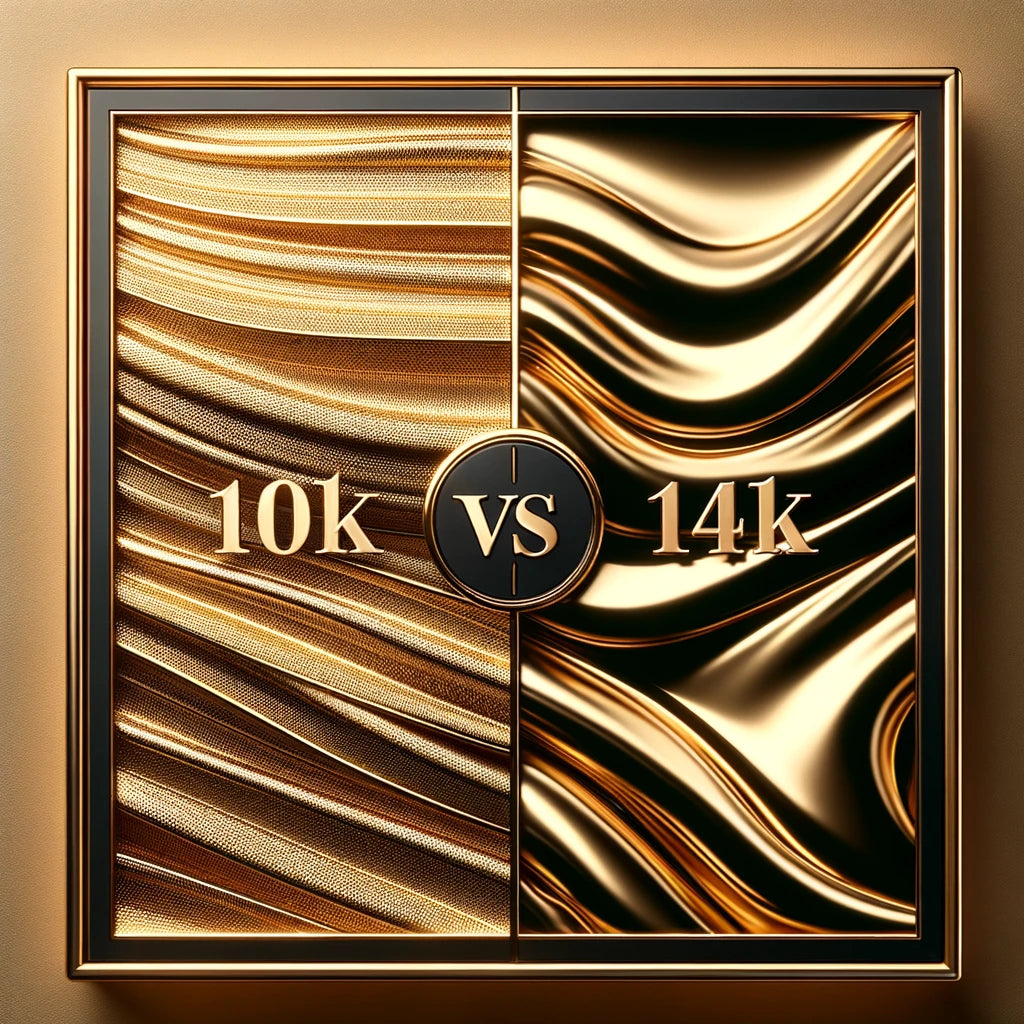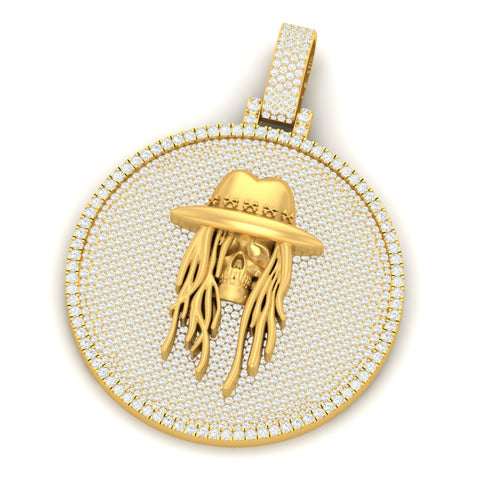Your Cart is Empty
Site under development -30% on the General Public Collection / CODE: "ICEVVS " - LIMITED STOCK
Site under development -30% on the General Public Collection / CODE: "ICEVVS " - LIMITED STOCK


Learn how to balance quality and value to find the best gold for your jewelry.
If you're looking for an engagement ring, earrings, necklace, or other gold jewelry, you've probably noticed that there are several types of gold, including 14K gold and 18K gold.
Since pure gold is an extremely soft and malleable metal, it is mixed with other metal alloys used to strengthen the gold.
10-karat gold is composed of 41.7% gold and 58.3% alloy. 10-karat gold is very durable and, given its relatively low percentage of pure gold, is the least expensive gold sold. The combination of durability and low cost makes 10K gold the ideal choice for budget-friendly jewelry such as bracelets, pendants, or earrings.
14K gold is composed of 58.3% gold and 41.7% alloying metals, making it purer and slightly more malleable than 10K gold. Due to its balance between price and durability, 14K gold is the gold of choice for approximately 90% of engagement rings sold in the United States.
The gold used in jewelry making is not pure gold, but almost always a mixture of gold and other metals.
In its pure form, gold is extremely soft and malleable. This means that when pure gold is used to make an engagement ring, necklace, or watch, the finished product is very easy to scratch, dent, warp, or otherwise damage.
Pure gold is also extremely lustrous, with a color closer to bright orange than the rich, warm gold most people associate with jewelry.
To improve its durability, gold is mixed with other metals before being made into jewelry. The purity of gold is measured using the karat system, which measures the ratio of pure gold to the secondary metals used in the alloying process.
Pure gold is 24K, meaning that 24 out of 24 parts are pure gold. This type of gold is not often used in jewelry, although 24-karat gold jewelry is sometimes used as an investment or heirloom in some parts of the world.
14K gold is composed of 14 parts gold mixed with 10 parts other metals. The specific metals used in this type of gold vary depending on the color of the gold. When you buy a 14 karat gold engagement ring, 58.3% of the ring is pure gold.
10K gold is composed of 10 parts pure gold mixed with 14 parts other metals. When you buy a 10K gold engagement ring, approximately 41.7% of the ring is pure gold.

Both 14K and 10K gold have their own pros and cons, ranging from durability and cost to purity and appearance. To help you decide which type of gold is best for you, we've listed the pros and cons of each type below.
The main advantage of 10K gold is its price. Since 10K gold is less pure than 14K gold, purchasing an engagement ring or other jewelry made from this type of gold is generally much less expensive.
Besides its lower price, 10K gold is slightly more durable than 14K gold. Because it's made with a smaller amount of pure gold and a larger amount of more durable metal alloys, this type of gold is more resistant to scratches, scuffs, dents, and other common damage.
The main drawback of 10K gold is its low purity. 10K gold contains only 41.7% pure gold, meaning that pure gold makes up less than half of the materials used to create this metal.
In the United States, 10K gold is actually the least pure form of gold that can be legally sold as gold jewelry.
This low purity level means that 10K gold has a duller appearance than 14K gold. Instead of the warm, rich color most people associate with gold, 10K gold can appear washed out and lack luster.
The low purity of 10K gold also means that it is more likely to trigger metal allergies than 14K gold jewelry.
For example, many people are allergic to nickel, which is commonly added as an alloying metal to gold used for jewelry. Because 10K gold contains more of these alloying metals than 14K gold, it is more likely to trigger skin allergies in people sensitive to nickel.
This can be a problem if your future fiancé is sensitive or allergic to nickel or another alloy metal used in gold.
14K gold has several unique advantages. The first of these is that it offers an excellent combination of purity and durability.
14K gold is made from 58.3% pure gold. This percentage is high enough to give 14K gold the warm, rich appearance of gold, without the dull color or lack of warmth that many people dislike in 10K gold.
Since 14K gold is also made up of over 40% metal alloys, it's durable enough for the vast majority of people. If your fiancée-to-be has an active lifestyle, a 14k gold ring will be resistant enough to scratches, dents, denting, and other damage for her to wear every day.
The higher purity level of 14k gold also means it's less likely to trigger metal allergies and cause skin reactions than 10k gold. If your fiancée-to-be has sensitive skin, 14k or 18k gold are safer metals than 10k gold.
Although 14K gold is slightly more expensive than 10K gold, it remains a very affordable metal for an engagement ring or other jewelry. For example, this classic six-prong solitaire engagement ring from Blue Nile costs $450 in 18K gold, but only $250 in 14K gold.
Finally, if you're looking for an engagement ring or other high-quality jewelry, it's easier to buy 14K gold than 10K gold. 14K gold is widely available from online jewelry retailers such as James Allen and Blue Nile, as well as most reputable jewelry stores.
These benefits have made 14K gold the most popular type of gold for engagement rings, with approximately 90% of all engagement rings being made of 14K gold.
Despite its advantages and popularity, 14K gold has some minor weaknesses that should be considered.
First of all, it's not the purest form of gold available for engagement rings. While 14K gold is more than pure enough to provide a rich, warm look, it's slightly less rich than 18K gold. That said, it's also less expensive and much more durable than other, purer forms of gold.
Second, 14K gold jewelry is slightly less durable than 10K gold jewelry. However, its durability is more than sufficient for most people, meaning it's not a consideration unless you expect your fiancé's ring to be subjected to serious abuse.
In general, we do not recommend purchasing an engagement ring or other jewelry made from 10K gold. Not only do none of the suppliers we recommend offer 10K gold as an option, but it is generally not a good choice due to its low purity, dull appearance, and risk of triggering skin allergies.
There's also the value factor. Yes, 10K gold is the cheapest type of gold. However, it's not much more affordable than 14K gold, which means you're only paying a small amount less for a much lower-quality metal.
Finally, since most reputable jewelers don't carry 10K gold, you're significantly limiting your options when purchasing it, which means you might not be getting the best deal on an engagement ring.
14k gold is popular for a reason: it offers the best combination of aesthetics, durability, and value. Even celebrities still often opt for gold engagement rings. That's why we recommend it over 10K gold if you're looking for a high-quality engagement ring, bracelet, pendant, pair of earrings, or any other fine gold jewelry.
If you need help choosing the right type of gold, we're here to help. Don't hesitate to contact us for free, personalized advice on engagement rings and other jewelry that best suit your tastes and budget.